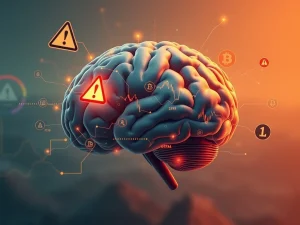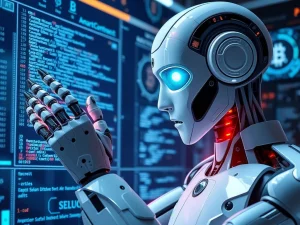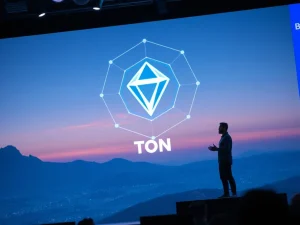Revolutionary Tether AI: Decentralized AI Merges with Bitcoin and USDT Payments

The world of technology is constantly evolving, and two fields attracting significant attention are Artificial Intelligence (AI) and cryptocurrency. What happens when these powerful forces merge? Enter Tether AI, a project poised to reshape how we think about intelligent systems and digital finance. For anyone invested in the future of crypto, understanding this development is crucial.
What is Tether AI and Why is Decentralized AI Important?
Tether AI is presented as an open-source, decentralized artificial intelligence platform. It comes from Tether, the company known for its USDt stablecoin. Unlike typical AI services that often rely on large, central servers, Tether AI operates on a distributed peer-to-peer (P2P) network. This design aims to provide users with greater privacy, autonomy, and system resilience. It’s built to be flexible, running on various hardware types, from mobile phones to desktop computers, without needing a single point of control or failure.
The importance of Decentralized AI lies in challenging the status quo. Current AI often requires users to send their data to third-party cloud services, raising privacy concerns. A decentralized approach means AI models can potentially run locally on a device or across a distributed network, keeping data more secure and giving users more control. Tether AI aligns with this vision, seeking to build AI tools that are censorship-resistant and not dependent on centralized APIs or platforms.
Seamless Crypto Payments with Tether AI
A key innovation of Tether AI is its native integration with cryptocurrency infrastructure. It directly supports Bitcoin (BTC) and USDt payments using Tether’s Wallet Development Kit (WDK). This means transactions can happen directly onchain, peer-to-peer. This feature makes Tether AI one of the first AI platforms to offer direct Crypto Payments functionality at the protocol level. According to Tether CEO Paolo Ardoino, this integration enables seamless transactions within the AI runtime itself.
This capability is significant because it allows for the potential creation of autonomous systems or software agents that can send and receive payments directly. Imagine AI applications that can pay for data access, services, or interact economically within a decentralized network, all settled with Bitcoin USDT directly via the platform.
Building Blocks: Tether WDK and Personal Infinite Intelligence
The concept of ‘personal infinite intelligence’ underpins Tether AI. This envisions AI agents that can be customized for individual users and adapted to different devices. Developers play a key role here, using the open-source Tether WDK (Wallet Development Kit), launched in late 2024. The WDK is designed to simplify the creation of self-custodial wallets across mobile, desktop, and web platforms.
Key features of the WDK include:
- Modularity: Allows developers to select and integrate specific wallet functions.
- Pre-built components: Provides ready-to-use tools for encryption, transaction management, and cross-platform compatibility.
- User sovereignty: Ensures users have complete control over their private keys and funds.
- P2P Integration: Supports integration with Tether’s other peer-to-peer projects like Keet and Pear.
The Tether WDK is crucial for embedding native Bitcoin USDT payments directly into decentralized AI applications, facilitating low-friction onchain transactions for both users and automated agents. It bridges wallet development with the broader Web3 and AI infrastructure.
Tether’s Expanding P2P Ecosystem: Keet and Pear
Tether AI is designed to integrate with Tether’s existing peer-to-peer initiatives. This includes Keet, a decentralized messaging application, and Pear, a framework for building P2P applications. The AI platform was initially revealed in late 2024 and is planned for launch in 2025. This move is part of Tether’s strategic restructuring, which created dedicated units for AI and P2P technologies like Tether Data.
Tether is also developing several AI-powered applications, such as a real-time translation tool, a voice assistant, and a Bitcoin wallet assistant. These projects demonstrate Tether’s view of AI as a foundational technology. The company’s expansion into AI follows strong financial performance, showing a commitment to innovation beyond its stablecoin dominance.
The Implications of Merging AI with Blockchain
The combination of AI capabilities with blockchain infrastructure and native Crypto Payments, as seen in Tether AI, signals a potential shift. It allows for the creation of applications that are not only intelligent but also financially autonomous and resistant to central control. Developers gain new tools to build adaptive AI systems that can run on various devices and handle real-time transactions.
For users, this model promises more control over personal data, enhanced privacy, and transparent interactions with AI services. It presents an open-source alternative to dominant cloud-based AI platforms, allowing for community-driven evolution. In the long term, this merging could impact sectors like decentralized finance (DeFi), content moderation, and Web3 gaming, positioning AI more like a transparent, modular public utility integrated with crypto.
Conclusion: A Glimpse into the Future
Tether AI represents a significant step in merging artificial intelligence with the principles of decentralization and cryptocurrency. By enabling native Bitcoin USDT payments and leveraging the Tether WDK within a Decentralized AI framework, Tether is building infrastructure for intelligent applications that prioritize user control, privacy, and resilience. This initiative challenges traditional centralized models and offers a glimpse into a future where AI and crypto work together to create more autonomous and open digital systems.









